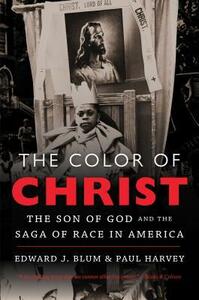Take a photo of a barcode or cover
31 reviews for:
The Color of Christ: The Son of God and the Saga of Race in America
Paul Harvey, Edward J. Blum
31 reviews for:
The Color of Christ: The Son of God and the Saga of Race in America
Paul Harvey, Edward J. Blum
Was excited to read something putting LDS art of Christ in a new category, but in the end it just felt flat for me. The arguments seemed to coincide with what was said about Christianity in America in general. It is more nuanced than what the authors presented.
Still would recommend even if there's more to be said about LDS visualizations of Christ.
Let’s get out in front of this potential quagmire from the get-go: There is no reliable way of knowing what Jesus actually looked like. The gospels of Matthew, Mark, Luke and John never reference his skin color. However, given what we know about first century populations of Galilee, it is reasonable and logical to assume that neither he nor his mother (nor any of the apostles) were white.
America, circa 1492
When white settlers first arrived in North America in the late fifteenth and early sixteenth centuries, they carried with them few if any renditions of Jesus. Because of the second commandment (Exodus 20:4), many religious pilgrims considered images of Christ impious or even blasphemous. Early homes and churches were devoid of paintings and drawings of the son of God. The Puritans who prayed for visions of Christ saw him the way the book of Revelation taught them to; they saw a blinding light or, most often, they saw nothing at all.
“Whether during witch hunts or lean times, Jesus as a physical presence or an embodied representation was nowhere to be found in this Puritan America.”
America, circa 1776
You would think, based on inference from today’s right-leaning pedagogues of history, that Jesus played a significant role in the collective psyche of the American Revolution—and you would be wrong.
“As a physical presence, he was almost completely absent, virtually nonexistent. In comparison to how prominent Jesus would become in the United States of the nineteenth and twentieth centuries, the revolution and the founding of a new nation were profoundly Christ-less.”
America, circa 1816
Enter the American Bible Society (ABS), followed closely by the American Sunday School Union (ASSU) and the American Tract Society (ATS). Three protestant organizations “dedicated to creating a strong and unified America.” These groups made available mass produced visual depictions of Jesus and other characters from the bible that were almost exclusively white.
“Suddenly engravings and etchings found their ways into churches, homes, schools, and outhouses.”
America, circa 1830
Standard Catholic and Protestant doctrine of the nineteenth century was more than a little vague on the value of casting Christ as Caucasian. Thankfully, we have Mormonism to clear things up. Joseph Smith and his followers made clear commonly held white Christian views; light skinned people were descendants of the literate and the godly, dark skinned people were descendants of the cursed and the profane.
“Mormon teachings offered explanations for the pressing racial questions of the day… What did God feel about people with dark skin? …As Mormon theology developed, dark skin represented sin that was present before an individual was born. Immorality darkened one’s skin while moral lives whitened the skin… In this racial mix, and given the political climate of the day, it was obvious and imperative that Jesus would be white.”
America, circa 1915
In the early years of the twentieth century, printed copies of Harold Copping’s The Hope of the World became fixtures in Sunday school classrooms across America. The painting featured five children gathered around a white Jesus. Four of the children are clothed and in physical contact with Christ. The only child that is naked and not physically touching this representation of God’s son is also (coincidentally?) the only black child. American white supremacists saw this setting as fitting and indicative of inherent black inferiority.
America, circa 1939
It was around the time of the Great Depression when a southern literary renaissance helped to further transform white Jesus into a totem of sanctified bigotry and exclusion. Several powerful politicians and business leaders (all of them white, of course) critiqued older images of Christ as “too feminine,” “too womanly,” and “antagonist to modern capitalism.”
“All my life I wondered how many people have been turned away from Christianity by the effeminate, sanctimonious, machine made Christs of second-rate, so-called art?” -Cecil B. DeMille
Conclusion
Throughout much of American history, images of a white Christ have served to sanctify white supremacy. Jesus was tethered to whiteness in film, art and politics. White American Christ is an image born in the early part of the 19th century and has become an image that Americans have glorified and been fighting over ever since.
Before Americans of Color came to know the white Christ as a liberator and spiritual redeemer they came to know him as a justification of slavery and as a symbol of manifest destiny and genocide. White Jesus presided over the buying and selling of human beings, and of the pilfering of indigenous lands—and he proclaimed it “good.”
Something to Think About
Even if you and millions of Americans like you find the race of Jesus irrelevant to your faith you still cannot avoid images of him and what those images have represented historically. There is an unnerving psychological perception that whiteness is superior and the image of white Christ helps to reinforce that racist delusion. This image helps to elevate and substantiate ascendancy without proof and without thought. White Jesus is inarguably a totem of racial hierarchy—why else would a burning cross and emblematic Christian iconography come to signify Christ’s endorsement of the ku klux klan?
White Christ helps to enable white men to become the center of privilege and opportunity. White + Christ = Power.
__________________________________
"The blond-haired, blue-eyed white man has taught you and me to worship a white Jesus, and to shout and sing and pray to this God that is his God, the white man's God. The white man has taught us to shout and sing and pray until we die, to wait until death, for some dreamy heaven-in-the-hereafter when we're dead, while this white man has his milk and honey in the streets paved with golden dollars right here on this earth!" -Malcolm X
__________________________________
SEE ALSO: Republican Jesus
https://www.goodreads.com/review/show/3748758036
I have been interested in The Color of Christ for a while, but I had not picked it up until Audible.com included it as part of the Audible Plus Catalogue. This new benefit allows members to listen to a couple thousand (mostly older) audiobooks for free.
The Color of Christ is a history of how Jesus has been portrayed and discussed throughout the history of the United States. My main takeaway is that while many have thought of Jesus as white, the actual images of Jesus as white, are relatively recent. Puritans had a strong iconoclast orientation as well as an understanding of the second commandment as including all representations of Jesus. While other Christian communities in the US were more likely to allow for pictures of Jesus, those groups were less culturally influential. It was not until around the 1820s that increased Catholic immigration and other forces started to weaken the cultural prohibitions to representing Christ.
Similar to what was illustrated in Jesus and John Wayne, the way that many argued against the Puritan opposition to representing Jesus Christ was as a means of Christian education. About that time, changes in printing technology allowed for low-cost pamphlets and books to include images. There is an interesting tidbit about the development of Mormon theology. Initially, Joseph Smith spoke about Jesus speaking to him through a bright light. But in later revisions of the story (in the 1820s), it was the tangible physical Jesus, who he described as White with blue eyes. That White Jesus became essential to the development of Mormon theology.
There are so many historical details that were new to me in this book. Part of what was new was Native American pastors that spoke out against white supremacy, slavery, and the lack of Christian ethics. Samson Occom wrote one of the first hymnals in the US and helped found, and fundraise for a school that was originally supposed to be for Native Americans but became Dartmouth. William Apess was a Native American pastor in the early 19th century. He passed away at only 41 but had written several books, including an autobiography and spoke out against the mistreatment of Native Americans and Black slaves and for the importance of being both a Christian and a Pequot.
Another detail I had never heard about was the (fake) Letter of Lentulus. This letter (probably from the 15th century) claimed to be from a Roman official contemporary with Jesus. It was first translated into English in 1680. The portion describing Jesus includes this passage:
He is a man of medium size (statura procerus, mediocris et spectabilis); he has a venerable aspect, and his beholders can both fear and love him. His hair is of the colour of the ripe hazel-nut, straight down to the ears, but below the ears wavy and curled, with a bluish and bright reflection, flowing over his shoulders. It is parted in two on the top of the head, after the pattern of the Nazarenes. His brow is smooth and very cheerful with a face without wrinkle or spot, embellished by a slightly reddish complexion. His nose and mouth are faultless. His beard is abundant, of the colour of his hair, not long, but divided at the chin.
This description widely impacted how Jesus was portrayed even though it was known to be a fake relatively early. Even early cinema portrayals of Jesus referenced the letter for 'historical accuracy'.
There is a good discussion about Sallman's Head of Christ, the most well known and commercially reproduce an image of Christ. Again, much of the push to reproduce the image was evangelistic and related, part of an opposition to the spread of communism. It is estimated that more than a billion copies of the image have been printed.
The strength of the book is that it talks about not just the art, but the culture around the art. There is a very good discussion about liberation theology and the development of Black and other representational images of Christ as well as the earlier backlashes against an overtly White Jesus. The book ends with recent tv and movies like The Passion, Dogma and South Park.
Take and read -- you'll benefit. Publication date is due in September.
Here is my full review: http://www.bobcornwall.com/2012/08/the-color-of-christ-review.html





